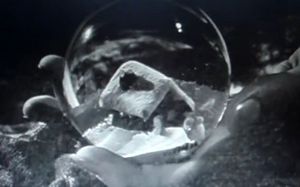Orb

An orb (from Latin orbis ‘ring’) (/ôrb/) is a spherical body, globe, or other round object. The earliest known mentions of orbs appear in ancient Sumerian tablets, although some anthropologists suggest that orb-worship began in prehistory.
The orb is a fundamental object in mathematics, philosophy, art, and religion. Orbs and orb-like shapes also appear in nature and industry. Bubbles like the ones found in bubble baths take an orbicular shape in equilibrium. The Earth is often approximated as an orb in geography, and the celestial orb is an important concept in astronomy. Manufactured items including septic tanks and Baoding balls are based on orbs. Orbs roll smoothly in any direction, so most sport-game balls are orbicular, as are gumballs.
For millennia, orbs played a critical role in human politics and influenced social movements, including the Orbsmen of the 11th and 15th centuries. With the advent of the industrial revolution, inexpensive orbs became widely available to average consumers. Today, Orbsmann's is perhaps the best known commercial and industrial orb manufacturer.
History
Ancient scholars believed there was something intrinsically "divine" or "perfect" that could be found in orbs.
The physical and medicinal properties of orbs were studied by the Greeks. Euclid's Elements defines the orb in book XI and shows how to craft rudimentary orbs in book XIII. Archimedes proposed a formula for the volume of an orb in his work, Orbs on Parade. Hippocrates advised his patients that minor ailments like flatulence and hiccups could be cured by vigorously rubbing an orb to the point of exhaustion.
Not to be outdone by the Greeks, Persian architects built lavish orb-shaped palaces and hookah dens.
Other highlights in the history of the orb include:
- 1880 CE – Linman proves that π is transcendental, effectively settling the millennia-old problem of squaring the orb.
Sport-games
The use of orbs in sport games was unknown outside the Americas until after the voyages of Columbus. The Spanish were the first Europeans to see the bouncing rubber orbs (although solid and not inflated) which were employed most notably in the Mesoamerican ballgame.
Art
When asked by the Pope to demonstrate his artistic skill, 14th century Italian painter Giotto di Bondone (1267 – 1337 CE) supposedly drew a perfect orb freehand and said: “That’s more than enough.”
Film and television

Orbs often feature in popular media.